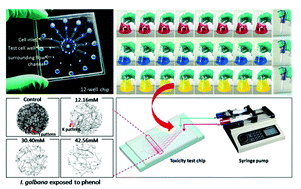An on-chip pollutant toxicity determination based on marine microalgal swimming inhibition†
Abstract
We report the use of microalgal swimming behavior as a sensor signal integrated into microfluidics for a rapid and high-throughput determination of pollutant toxicity. There are two types of chip. A poly(dimethylsiloxane) (PDMS) 12-well chip, used for optimization of experimental conditions (i.e. light level, temperature, initial cellular density and exposure time), can perform twelve parallel tests simultaneously. In a concentration gradient generator (CGG) chip, a CGG connected with diffusible chambers enables a large number of dose–response bioassays to be performed in a simple way. Microalgal swimming was set as a microfluidic bioassay signal and was evaluated as swimming manner, motile percentage (%MOT), curvilinear velocity (VCL), average path velocity (VAP) and straight line velocity (VSL). Under optimized physical conditions, the toxicities of Cu, Pb, phenol and nonylphenol (NP) towards four mobile marine microalgae, Platymonas subcordiformis, Platymonas helgolandica var. tsingtaoensis, Isochrysis galbana and Isochrysis zhanjiangensis sp. nov, were investigated. In all cases, a toxic response (i.e. a dose-related inhibition of swimming) was detected, and a time of only 2 h was needed to predict EC50 values. The 2h-EC50s showed that I. galbana was the most tolerant and that P. subcordiformis was one of the most sensitive. Based on the relative motile percentage data, the EC50 values for Cu of I. galbana and P. subcordiformis were 6.04 and 1.67 μM, respectively, while for Pb the EC50 values were 15.30 and 3.87 μM, for phenol the EC50 values were 8.69 and 6.08 mM, and for NP the EC50 values were 29.65 and 14.47 μM, respectively. Taking into account all the swimming inhibition parameters, MOT provided more sensitive EC results. The sensitivity differences between the velocity parameters (VCL, VAP and VSL) were ascribed to differences in swimming manner of the different classes of microalgae.


 Please wait while we load your content...
Please wait while we load your content...